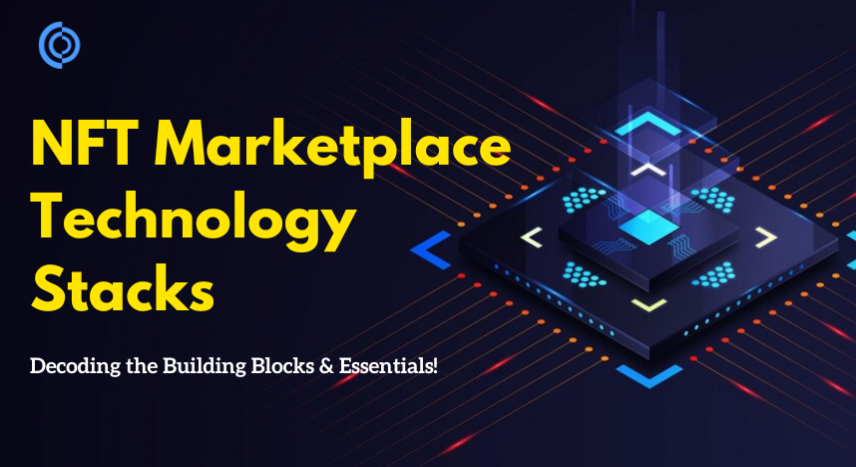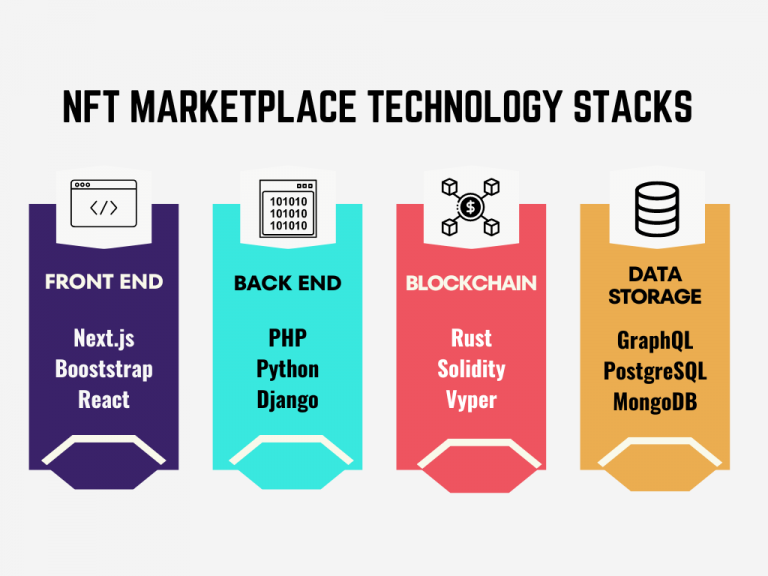NFT Marketplace is a vibrant place where business and NFT enthusiasts live and explore. It’s like stepping into a zippy spot, where every click opens the door to unique digital wonders. Statistics say the average revenue of a single user in the NFT market amounts to US$138.80 in 2024 and revenue of the NFT Marketplace will reach US$2,378.00 Million by the end of 2024.
Creating such a digital revolution is not so easy. When it comes to NFT Marketplace development, a lot of technology should be incorporated. For turning ideas into reality, transactions into experience, and ordinary to extraordinary, the ultimate gamer is the technology stack. When one thinks about developing an NFT Marketplace then one should also be aware of the top tech stack require to build an NFT platform. Let’s know about the game changer – “NFT Marketplace Tech stack” in detail here! Before that, let me go with the basics…
Overview of NFT Marketplace
NFT Marketplace is a digital platform where one can effortlessly sell or buy Non-Fungible Tokens (NFTs). These tokens are purchased or auctioned to a predetermined price. To utilize this marketplace, one needs to have a crypto wallet in order to make trades or store the tokens. Users can create an account and can post their digital artwork to sell it on the NFT Marketplace. One can have a wide range of categories in one place. There are various categories that you can list on the NFT Marketplace. Namely:
- Digital piece of art
- Digital collectible
- NFT art app
- Unique dresses/handbags
- In-game collectibles
- Music track
- Essay/Creative Writing.
In this NFT Marketplace, artists and creators can tokenize their work, providing a secure and verifiable proof of ownership. This has empowered creators to monetize their digital creations directly, eliminating the need for traditional intermediaries. Thus NFT Marketplace is definitely showcasing the potential for blockchain technology to reshape how we create, buy, and sell unique digital assets.
Also read : How to build an NFT Marketplace Platform
Having known about this. Let’s get in-depth knowledge of the building blocks ~ NFT Marketplace Tech stack, which give life to them.
Top NFT Marketplace Tech Stack to look out
A Technology Stack is a combination of programming coding languages, databases, frameworks, and tools used to build an application platform. The NFT Marketplace Tech stack determines the scalability, security, and overall performance of the platform. The platform’s success is based on the tech stack involves in the development process. They are.
Front-end Framework
The Front-end framework is nothing but what the users can see when they enter your website page. The buttons, checkboxes, graphics, and text are all front-end developments. The widely used frontend frameworks are,
Next.js – One of the widely used server-side rendering frameworks is Next.js. It’s a framework for React that enables developers to use it in any application. Next.js comes with built-in features like automatic code splitting, and optimized performance that make it easy for developers to create scalable and high-performance web applications.
Bootstrap – The open-source front-end framework used for responsive, mobile-first project development on the web is Bootstrap. This makes the CSS and JavaScript-based stylish patterns to furnish formatting for topography, formularies, buttons, navigation, and additional interface constituents. An important usage of Bootstrap is that it simplifies the mechanism of creating a responsive web application that works well on both desktop and mobile phones.
React – React is a JavaScript Library. Its main purpose is to build highly – engaging user interfaces for single-page applications. Also, it guides the development of reusable user interface elements that can be incorporated into various areas of the applications. And, it allows users to manage complex UI and speeds up development time.
Back-end Framework
Back-end Framework is the data and infrastructure that make your application work. The widely used backend frameworks are,
PHP – HyperText Preprocessor. It’s a widely used open-source, scripting language that suits web development and can be embedded into HTML. It supports different types of databases such as MySQL, Oracle, and PostgreSQL.
Python – Python is a flexible high-level programming language that can be used for web development, AI, and so on. It has a huge collection of libraries and frameworks which makes the development process easy and quick.
Django – It is an open-source, high-level Python-based programming language used for web frameworks. It follows MTV(Model – Template Views), Architectural patterns, etc. This framework supports rapid development and clean projection. Django-developed apps are extremely secure.
Blockchain
Rust – Rust is a system programming language that provides high memory satisfaction and prevents faults while improving performance. This quality of rust makes it perfect for blockchain development. Rust is the development of blockchain Frameworks including Smart Contracts.
Solidity – Solidity is an advanced programming language employed for agreements on the Ethereum blockchain. It is the same as JavaScript and helps developers to create decentralized apps on the Ethereum platform. It’s a very secure one and it has features like contract inheritance and libraries which make the code reusable.
Vyper – Vyper is called a Python-based Ethereum Virtual Machine (EVM) which is built to be more secure and auditable than solidity. The coding syntax is very simple and has fewer features than solidity which makes it easier to curate a code. Vyper is the best choice for developing simple and secured Smart Contracts.
Data Storage
GraphQL – It’s a query language that helps to retrieve data from a graph database. It provides an efficient way of retrieving data and helps the developers to specify what specific data they want. This enables features like catching, batching, real-time updates, and so on. Due to these many features, it has become a popular choice for building APIs.
PostgreSQL – It is the newest objective- a relational database administration strategy that supports SQL Idioms. PostgreSQL is a database that is reliable and scalable by handling a large amount of data. It provides you with features like JSON (JavaScript Object Notation) storage, full-text search, and transaction support to build your web applications.
MongoDB – MongoDB is designed to handle a large amount of unstructured data. It provides features like auto sharding, indexing, and replica sets which make it possible to build real-time applications.
Smart Contracts
Smart Contracts play an important role in NFT Marketplace development. It is deployed in the blockchain and resolves the disputes between two parties without any third-party intervention. Smart contracts are written in a solidity programming language that currently serves as a core language on Ethereum and other private blockchains. It supports all the data types in programming Languages such as Boolean, integer, string, modifier, array, etc. The rules and limitation is build into the network’s code.
The code will specify the steps that needs to execute the contract once specified conditions are met. This code enters in the blockchain network and executes when the circumstances is positive. Once the contract enters into a Blockchain network, it cannot be changed or altered. The purpose of using Smart Contracts is based on 3 categories. They are:
Efficiency – The contract executes at a high speed.
Accuracy – No – chance for human errors.
Immutability – It cannot be changed or altered.
Wallet Integration
One cannot use the NFT platform without the wallet. Every NFT Marketplace must have a wallet, which helps users to send and receive crypto assets in seconds. Wallet integration should be compatible with both iOS and Android platforms. With this, the user can maintain ownership and control over their digital asset. The technical components and the standards contribute to the smooth functioning of the wallet. It allows users to access and display the metadata when interacting with NFTs. MetaMask, trust wallet, Coinbase wallet, etc.. are examples of digital wallets in the NFT Marketplace.
Payment Gateway Integration
NFT Marketplace is where users trade digital assets. For doing so, Payment Gateway has become more necessary to do nowadays. If you’re going with NFTs, only crypto-to-crypto transactions are helpful. So, a payment gateway is a payment network that makes it easy to transfer your crypto. It supports all virtual assets for payments regarding Bitcoins, Ethereum, USDT, Matic, Cardano, Solana, and other cryptos. It’s a global usage development for merchants trading with cryptos. Transaction fees are low and can go as low as zero.
As of now, more businesses started accepting crypto payments, so there is a huge range of use of crypto to make online payments. The crypto payment gateway in the NFT Marketplace comes up with special software tools to take the crypto payments process seamlessly. One can even integrate multi-currency crypto payment gateway like Bitpay, Coin Gate, and Shopify Gateway.
Now that you have gained insights into the top NFT Marketplace Tech stack needed. It is mandatory to know about the necessary features in the NFT Marketplace Platform to run seamlessly.
Necessary Features of NFT Marketplace Development
- Registration – This is the primary feature of the NFT Marketplace, where users create an account to use a marketplace in just a few clicks.
- Creation & Management – The marketplace must have a creation and management feature. Creators should be able to upload their assets and mint the NFTs.
- Storefront – The storefront of NFT Marketplace is like an online store. So it should be attractive and easily to navigate for users.
- Search Bar – This NFT Marketplace feature allows users to easily search for their choice of NFTs in music, video photographs, art memes, gaming characters & much more.
- Listings – Listings in an NFT Marketplace is an important feature that enables the sellers to develop and send collectibles.
- Filters – Search filters are one of the ways to improve a buyer’s experience. In the NFT Marketplace, users should be able to sort items by categories such as price, rarity, and artist via the filter option.
- Buying & Auction – The NFTs can be sold through auctions where users and buyers can bid for NFTs. It’s another way of selling mechanisms in the NFT Marketplace.
- Community Features – A vibrant NFT Marketplace should have community features that allow users to connect, share, and learn with others. This includes forums, social media integration, user-generated content, etc…
- Push Notification – Updating and engaging the users with the new and trendy NFTs through notifications.
- Security Measures – The NFT Marketplace should be very secure for the users to trade. It should be responsible for hack-free and other security services.
Adding these exciting features in your NFT Marketplace will keep your users connected with the trading and make them stay longer on the website. Now, Let’s see where to build these features into reality.…
Create an NFT Marketplace Platform with Perfect Tech Stacks!
Essential Tools. Decentralized Storage. Best Frameworks. Streamlined Process.
Where to Build this Tech-rich NFT Marketplace?
As said already, Technology Stack is a major component of the NFT marketplace that provides scalability, security, and performance to the platform. So to make a successful venture in the NFT Marketplace business then you need to choose the right one to develop the NFT Marketplace platform with great tech stack in it. On that note, Coinsclone is one such professional NFT Marketplace Development Company that develops NFT Marketplace platforms with spectacular tech stack. Further picking our service is a one-stop solution, for all your NFT Marketplace developments. 500+ notable projects are promptly completed and for more understanding, can try out the free demo session. Definitely connecting with us will help you achieve goals and win the crypto market.

